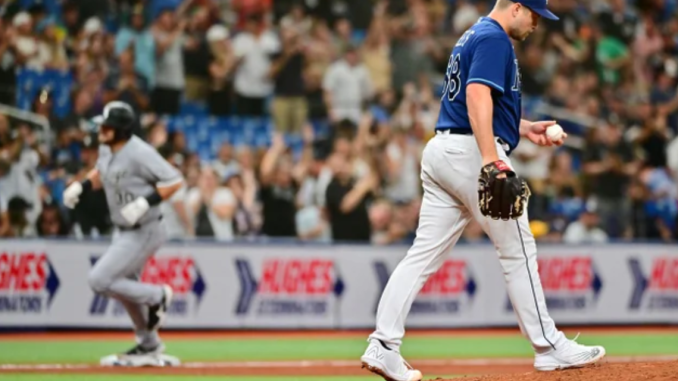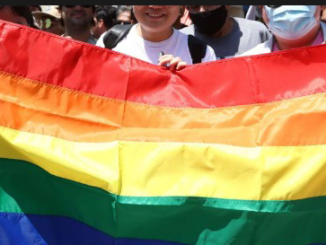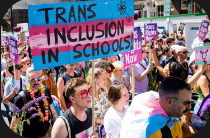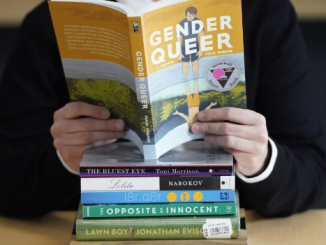
The Tampa Bay Rays held the team’s annual LGBTQ Pride Night on Saturday, with many of the players wearing a rainbow on their uniform to signify that LGBTQ people are welcome at the ballpark.
Yet a number of players on the team refused to wear the rainbow or demonstrate support for the community, with a spokesperson saying they did so based on religious objections to homosexuality.
The Tampa Bay Times has identified at least five players on the Rays team — pitchers Jason Adam, Jalen Beeks, Brooks Raley, Jeffrey Springs and Ryan Thompson — who rejected the rainbow, and in doing so rejected the LGBTQ community. Raley and Beeks both played in the 3-2 loss to the Chicago White Sox.
Adam was the apparent appointed spokesperson for the group, speaking after the game. From the Tampa Bay Times:
A lot of it comes down to faith, to like a faith-based decision. So it’s a hard decision. Because ultimately we all said what we want is them to know that all are welcome and loved here. But when we put it on our bodies, I think a lot of guys decided that it’s just a lifestyle that maybe — not that they look down on anybody or think differently — it’s just that maybe we don’t want to encourage it if we believe in Jesus, who’s encouraged us to live a lifestyle that would abstain from that behavior, just like (Jesus) encourages me as a heterosexual male to abstain from sex outside of the confines of marriage. It’s no different.
It’s not judgmental. It’s not looking down. It’s just what we believe the lifestyle he’s encouraged us to live, for our good, not to withhold. But again, we love these men and women, we care about them, and we want them to feel safe and welcome here.
The statement is chock full of ridiculousness, namely: Hiding behind a Christian faith that at its true core actually values inclusivity and rejects judgment; Denying the Pride rainbow says very clearly LGBTQ people are not welcome; Being gay is not a ‘lifestyle’; And the idea that this decision is not ‘judgmental’ or that these men are ‘not looking down’ at LGBTQ people is complete and utter bullshit.
With that being said, many of the players, as well as team manager Kevin Cash, did in fact wear the rainbow during Saturday’s game. Outfield Kevin Kiermaier put it perfectly:
It’s one of those things, my parents taught me to love everyone as they are, go live your life, whatever your preferences are, go be you. I can’t speak for everyone who’s in here, obviously, but this is a family-friendly environment here at a big-league ball field. … We just want everyone to feel welcomed and included and cheer us on. No matter what your views on anything are.
While many people will focus on the refusal of some players to wear the rainbow — and that certainly deserves attention — some very serious scrutiny should be aimed at club management who, frankly, royally screwed this up.
For starters, no one expects an MLB team to wear rainbows on their jersey during a Pride Night. It’s great if it happens, and it is certainly a powerful statement about the inclusive values of the club; There’s a lot of positive about doing so. Yet it’s not as though the Rays had to attempt to do this. If they weren’t all going to do it, they should have punted. This was, it can be said, an unforced error.
And if the club does decide to wear a rainbow, they need to effectively communicate with player leadership and various levels of management to build a consensus of support and make it clear that everyone’s got to do it.
Can you imagine the club that would allow a player to opt out of wearing a 42 on his jersey for Jackie Robinson Day? Or refuse to wear some camo for a Military Appreciation Day? Complete disaster.
Unfortunately, the Rays management approached this differently, allowing homophobia amongst a handful of 20-somethings to to drive the uniforms that some of the players wore.
Team uniforms — caps and jerseys — are supposed to be that: uniform. They’re all supposed to be the same. That’s the entire point of uniforms.
I’m left wondering why players on the same team wearing different uniforms was not a violation of MLB rules.
Finally, given Adam’s statement on behalf of the players, the club failed to communicate this effort accurately and effectively to its players. This is the biggest failure of the club.
Wearing a rainbow on a uniform doesn’t say “I encourage two men having sex together.” It says “You’re welcome in this ballpark.” That’s it.
As I often say, I don’t need people to accept who I am or that I sleep with my husband; I do need people to respect me.
By Adam’s own statement on behalf of the players, they agree with the actual reason people wear a rainbow or support Pride: welcoming everyone to the ballpark. Yet that was clearly not correctly communicated with the players.
Because of club management’s utter failure, and the players allowing their homophobia to dictate their actions, instead of talking about the strong LGBTQ support that exists in Major League Baseball and within the Rays’ organization, all anyone is talking about from that game is the players who don’t want to support gay “behavior.”
What a disaster.
Who has handled the whole situation of rainbows on team uniforms well? The Los Angeles Dodgers and San Francisco Giants. These two clubs have worked hard to get full support for their Pride-uniform initiates from player and team leadership, resulting in every player and coach wearing a rainbow cap at the Dodgers’ Pride Night last Friday; Both clubs will have all players wearing them when they play each other during the Giants’ Pride Day this Saturday.
Does that mean that every single player and coach on these teams has reconciled their church’s possible doctrine with homosexuality? Of course not.
It means club management has effectively communicated with players and found a welcoming path forward together.
I’m afraid this episode will have a chilling effect on Pride uniforms going forward. It shouldn’t. What it should lead to is more open, honest dialogue within clubhouses and building an environment where people can have disagreements, but where everyone rolls out the red carpet to welcome people whether they are Christian, gay, Black, trans, a military veteran or anyone else.
* Article from: outsports.com


